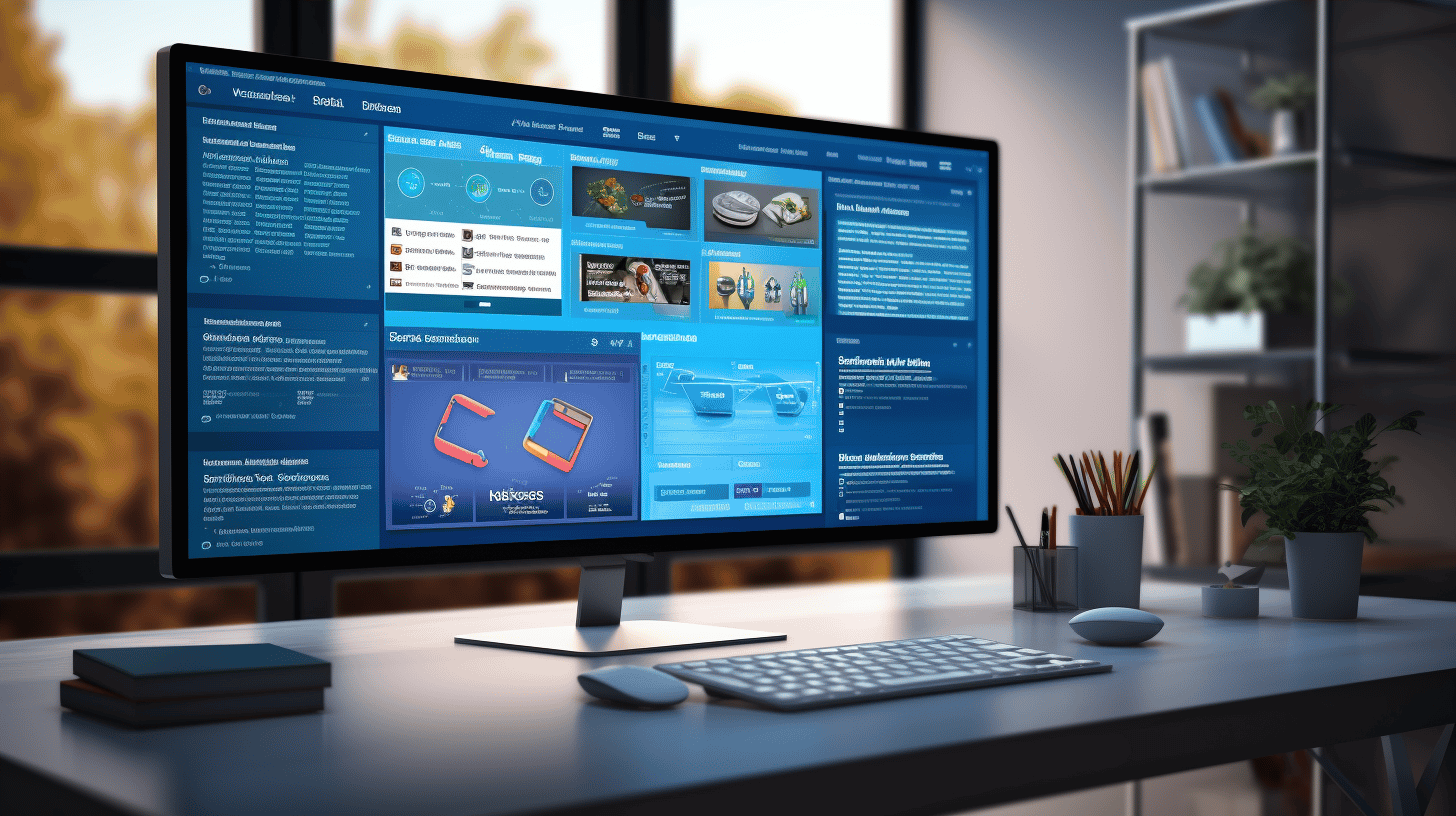WordPress 已成为全球最受欢迎的内容管理系统 (CMS) 之一,为数百万个网站提供支持。其用户友好的界面和广泛的主题和插件使其成为初学者和经验丰富的网站所有者的理想选择。但是,有效地管理 WordPress 网站需要一些知识和诀窍。在本文中,我们将探讨一些基本技巧和工具,它们可以帮助您像专业人士一样浏览 WordPress 并确保您的网站成功。
无论您是企业主、博主还是设计师,了解 WordPress 的基础知识对于最大限度地发挥其潜力都至关重要。从浏览 WordPress 仪表板到选择正确的主题和使用插件,拥有坚实的基础将让您走上成功之路。
掌握基础知识后,我们将深入探讨一些有效管理 WordPress 网站的实用技巧。其中包括保持 WordPress 和插件更新、选择正确的主题、明智地使用插件、优化网站性能、保护网站安全、定期备份以及利用 SEO 策略提高可见性。
为了让您的 WordPress 管理之旅更加顺利,我们还将向您介绍一些可以增强您网站功能和性能的有用工具。从页面构建器插件到 SEO 工具、安全插件到备份解决方案,这些工具将使您的网站管理更上一层楼。
最后,我们将讨论 WordPress 网站维护的最佳实践。从数据库维护到图像优化、缓存以提高性能、垃圾邮件防护和检查断开的链接,这些做法将确保您的网站保持最佳状态。
所以,拿起你的咖啡,舒适地坐下,让我们深入 WordPress 管理的世界吧!🚀
了解 WordPress 基础知识
您是 WordPress 新手吗?别担心,我们会为您解答!在本节中,我们将为您提供 WordPress 的简要概述,帮助您浏览 WordPress 仪表板,并解释 WordPress 主题和插件的重要性。在本节结束时,您将对基础知识有扎实的了解,并准备好更深入地了解 WordPress 的世界。
WordPress 简介
WordPress 是一个内容管理系统 (CMS),可让您轻松创建和管理网站。它最初是作为博客平台开发的,但已发展成为全球数百万个人、企业和组织使用的强大工具。
WordPress 最大的优势之一是其灵活性。它提供了广泛的特性和功能,可以根据您的特定需求进行定制。无论您是想创建个人博客、在线商店还是公司网站,WordPress 都有工具可以帮助您实现目标。
浏览 WordPress 仪表板
WordPress 仪表板是您网站的控制中心。在这里,您可以管理内容、自定义网站外观以及通过主题和插件添加新功能。要访问仪表板,您只需使用用户名和密码登录 WordPress 网站即可。
登录后,您将看到一个用户友好的界面,可轻松访问所有基本功能和设置。仪表板分为不同的部分,包括:
- 帖子:您可以在这里创建和管理您的博客帖子或文章。
- 页面:使用此部分创建和管理您网站上的页面,例如“关于”或“联系”页面。
- 媒体:在这里,您可以上传和管理想要包含在内容中的图像、视频和其他媒体文件。
- 外貌:此部分允许您使用主题自定义网站的外观,并自定义网站的菜单、小部件和背景。
- 插件:插件就像是 WordPress 网站的应用程序,可以添加特定的特性和功能。在插件部分,您可以安装、激活和管理要在网站上使用的插件。
- 设置:在设置部分,您可以为您的网站配置各种选项,例如网站标题、时区和永久链接结构。
了解 WordPress 主题和插件
WordPress 主题和插件是 WordPress 网站的基本组件,可让您自定义和扩展其功能。让我们仔细看看每一个:
主题
WordPress 主题是一组文件,用于确定您网站的外观和布局。您可以将其视为您网站的“皮肤”。使用 WordPress,您可以从数千个免费和高级主题中进行选择,每个主题都提供独特的设计和功能集。
主题在创建具有凝聚力和视觉吸引力的网站方面起着至关重要的作用。它们控制着网站的颜色、字体、页面布局和整体风格等。您可以轻松在主题之间切换或自定义主题以匹配您的品牌和个人偏好。
插件
另一方面,插件就像是 WordPress 网站的附加功能,可以扩展其默认功能之外的功能。有数千个插件可用,涵盖广泛的功能,例如 SEO 优化、联系表单、电子商务功能、安全增强等。
插件可让您向网站添加特定功能,而无需编码。 您可以通过 WordPress 仪表板的插件部分轻松安装、激活和配置它们。
无论您需要添加社交媒体共享按钮、创建会员网站还是针对搜索引擎优化您的网站,插件都能提供您需要的解决方案。
现在我们已经介绍了 WordPress 的基础知识,您可以更深入地了解 WordPress 网站创建、自定义和管理的世界。继续探索功能和可能性,充分发挥这个强大平台的潜力。
有关 WordPress 基础知识的更多详细信息,请参阅我们的综合指南 了解 WordPress 基础知识.
有效管理 WordPress 网站的基本技巧
欢迎来到 WordPress 网站管理的世界!无论您是经验丰富的专业人士还是刚刚起步,了解如何有效地管理您的 WordPress 网站都很重要。从保持核心 WordPress 安装和插件的更新,到优化性能和保护您的网站免受网络威胁,本文将为您提供必要的提示和见解,以帮助您取得成功。那么,让我们开始吧!
保持 WordPress 和插件更新
定期更新 WordPress 核心安装和插件对于维护网站的安全性和功能至关重要。更新通常包含错误修复、功能增强,最重要的是安全补丁。以下是更新时需要注意的一些要点:
- 了解最新动态:密切关注 WordPress 仪表板以获取任何可用更新。建议在新版本发布后立即更新您的网站。
- 更新前备份:在执行任何更新之前,请务必对您的网站进行完整备份。这样,如果在更新过程中出现任何问题,您可以轻松地将网站恢复到以前的状态。
- 在暂存环境中测试更新:如果您的网站很复杂或者依赖高度定制的主题和插件,建议先在临时环境中测试更新,然后再在您的实时网站上实施它们。
- 关注兼容性:某些更新可能与您当前的主题或插件不完全兼容。更新前请务必检查兼容性问题,并在必要时向开发人员寻求指导。
选择正确的主题
为你的 WordPress 网站选择合适的主题将为你网站的设计和功能奠定基础。无论你是选择 WordPress 存储库中的免费主题还是购买高级主题,你都应该考虑以下几点:
- 目的和设计:定义网站的目的和期望的外观。您是在创建博客、电子商务商店还是作品集?选择符合您的目标且具有您想要的设计元素的主题。
- 响应能力:在当今以移动为中心的世界中,拥有一个响应式主题来提供跨各种设备和屏幕尺寸的无缝浏览体验至关重要。
- 自定义选项:寻找提供多种自定义选项的主题,例如配色方案、字体选择和布局变化。这样,您就可以创建一个独特而个性化的网站。
- 用户评论和评分:花点时间阅读您正在考虑的主题的用户评论和评分。这将为您提供有关主题性能、灵活性和支持的宝贵见解。
明智地使用插件
WordPress 插件是扩展网站功能的绝佳方式。但是,明智地使用它们非常重要,以避免不必要的膨胀和潜在的冲突。请遵循以下最佳做法:
- 质量胜于数量:仅安装网站功能所需的插件。插件过多会降低网站速度并增加兼容性问题的风险。
- 声誉和评论:在安装插件之前,请检查其声誉和其他用户的评论。寻找维护良好、定期更新且支持良好的插件。
- 定期检查并更新插件:密切关注您安装的插件,并定期检查其性能和兼容性。删除任何未使用或过时的插件,因为它们可能带来安全风险。
- 插件冲突:在某些情况下,插件可能会相互冲突或与您的主题冲突。如果您在安装新插件后遇到问题,请尝试逐个停用其他插件以找出冲突。
优化网站性能
性能良好的网站不仅可以提供更好的用户体验,还可以提高搜索引擎排名。以下是优化 WordPress 网站性能的方法:
- 图像优化:压缩并优化图像以减小文件大小,同时不影响质量。使用 Smush 或 EWWW Image Optimizer 等插件来自动执行此过程。
- 缓存:实施缓存解决方案,例如 W3 Total Cache 或 WP Rocket 等插件来存储网页的静态版本,从而减少服务器负载并提高网站速度。
- 最小化并合并文件:缩小 CSS 和 JavaScript 文件以删除不必要的字符、注释和空格。您可以使用 Autoptimize 或 Fast Velocity Minify 等插件来实现此目的。
- 托管性能:为您的 WordPress 网站选择可靠且快速的托管服务提供商。如果您希望获得更高的性能、安全性和可扩展性,请选择托管式 WordPress 托管。
保护您的 WordPress 网站
保护您的 WordPress 网站免受网络威胁至关重要。网站被入侵可能会导致数据泄露、失去客户信任并损害您的品牌声誉。请通过以下方式积极主动地保护您的网站:
- 使用强登录凭证:确保您的用户名和密码组合安全,以防止未经授权的访问。避免使用常见或容易猜到的密码。
- 定期更新:我们之前提到过这一点,但值得重复一遍。保持 WordPress 核心、插件和主题更新是抵御安全漏洞的第一道防线。
- 安装安全插件:利用 iThemes Security 或 Sucuri Security 等安全插件来增加额外的保护层。这些插件可以帮助检测和阻止您网站上的恶意活动。
- 启用双重身份验证:实施双因素身份验证 (2FA) 以增强登录安全性。这要求用户提供第二个验证步骤,例如发送到其移动设备的唯一代码。
- 定期扫描恶意软件:使用 Wordfence 或 MalCare 等插件执行常规恶意软件扫描,以识别您网站上的任何恶意代码或恶意软件。
有关保护 WordPress 网站的详细信息,请参阅我们的文章 保护您的 WordPress 网站.
现在您已经为有效管理 WordPress 网站打下了坚实的基础,请继续关注下一节中的其余提示。请记住,通过保持 WordPress 核心和插件更新、选择正确的主题、明智地使用插件、优化性能和保护您的网站,您将顺利踏上成功的 WordPress 之旅!祝您管理愉快!😊
有用的 WordPress 工具,可实现更好的网站管理
介绍:
管理 WordPress 网站可能是一项艰巨的任务,但只要使用合适的工具,它就会变得更容易管理。从设计和 SEO 到安全和性能优化,都有插件可以帮助您管理网站的各个方面。在本文中,我们将探讨一些最有用的 WordPress 工具,这些工具可以增强您网站的功能并让您的生活更轻松。那么,让我们开始吧!
WordPress 页面构建器插件
使用 WordPress 的最大优势之一是无需任何编码知识即可创建令人惊叹的网页。WordPress 页面构建器插件在这方面改变了游戏规则。这些插件提供了用户友好且直观的界面,可让您轻松设计和自定义您的网站。一些流行的页面构建器包括:
- 元素:功能强大且丰富的页面构建器,提供预建模板、拖放功能和广泛的设计选项。
- 海狸建造者:Beaver Builder 以其简单性和速度而闻名,它提供了一个干净且易于使用的界面来构建漂亮的网站。
- Divi 构建器:借助其可视化的拖放编辑器,Divi Builder 可以轻松创建独特且引人注目的布局。
适用于 WordPress 的最佳 SEO 插件
如果您希望您的网站在搜索引擎结果中排名靠前并带来自然流量,则需要针对搜索引擎进行优化。 SEO 插件可以帮助您实现此目标。 以下是 WordPress 的一些必备 SEO 插件:
- Yoast搜索引擎优化:一个全面的 SEO 插件,可以分析您的内容、提出优化建议并帮助您改善页面 SEO。
- 一体化SEO包:该插件提供了一系列用于优化您的网站的高级功能,包括 XML 站点地图生成、社交媒体集成等。
- 排名数学:凭借其用户友好的界面和高级功能,Rank Math 作为 WordPress 用户强大的 SEO 工具越来越受欢迎。
安全插件
网站安全应该是每个网站所有者的首要任务。随着网络威胁的增加,拥有强大的安全插件至关重要。以下是一些值得信赖的 WordPress 安全插件:
- 苏库里安全:一套完整的安全套件,提供恶意软件扫描、防火墙保护和安全审计,以确保您的网站安全。
- Wordfence安全:Wordfence Security 以其防火墙和恶意软件扫描功能而闻名,是 WordPress 最受欢迎的安全插件之一。
- iThemes 安全:iThemes Security 原名为 Better WP Security,提供超过 30 种安全措施来保护您的网站免受漏洞攻击。
备份工具
定期备份对于确保网站数据的安全性和完整性至关重要。如果发生服务器故障、黑客事件或意外数据丢失,拥有可靠的备份解决方案可以挽救局面。以下是一些推荐的 WordPress 备份工具:
- UpdraftPlus:凭借其简单的设置和调度选项,UpdraftPlus 允许您自动备份并将其存储在您选择的安全位置。
- 备份伙伴:这个高级备份插件提供了一系列功能,包括自动备份、异地存储选项和轻松恢复备份。
- VaultPress:VaultPress 由 WordPress.com 背后的公司 Automattic 开发,提供实时备份、自动恢复以及与 Jetpack 的无缝集成。
性能和优化插件
网站加载缓慢会对用户体验和搜索引擎排名产生负面影响。性能和优化插件可帮助您提高网站速度和整体性能。考虑使用这些插件来优化您的网站:
- WP火箭:一种流行的缓存插件,通过生成静态 HTML 文件并优化网站的各个性能方面来缩短页面加载时间。
- W3 总缓存:此插件提供缓存、缩小和 CDN(内容分发网络)集成,以提高您的网站速度和性能。
- 斯马什:图像优化对于缩短加载时间至关重要。Smush 会自动压缩和优化您网站上的图像,而不会影响质量。
通过利用这些有用的 WordPress 工具,您可以增强网站管理并为访问者创造更好的体验。记得查看我们的 WordPress 插件推荐 了解更多见解和插件建议。祝您网站管理愉快!🚀
WordPress 网站维护的最佳实践
维护 WordPress 网站对于确保其最佳性能和安全性至关重要。定期维护任务可以大大有助于保持您的网站平稳运行并提供出色的用户体验。在本文中,我们将探讨一些 WordPress 网站维护的最佳实践,以帮助您最大限度地发挥网站的潜力。
数据库维护
数据库是 WordPress 网站的骨干,用于存储所有内容、设置和其他重要数据。随着时间的推移,数据库可能会因不必要的信息而变得臃肿,导致加载时间变慢和性能下降。为了使数据库保持良好状态,定期执行维护任务非常重要,例如:
- 清理未使用和重复的数据: 删除占用数据库空间的未使用的主题、插件和媒体文件。
- 优化数据库表: 定期优化数据库表以减少其大小并提高性能。
- 备份数据库: 定期备份数据库可确保您拥有网站数据的副本,以防出现任何不可预见的问题。
图像优化
图片在吸引网站访问者方面起着至关重要的作用,但如果优化不当,它们也会减慢网站速度。为了确保快速加载时间并改善整体用户体验,请考虑以下图像优化技术:
- 压缩图像: 使用 Smush 或 EWWW Image Optimizer 等工具,在不牺牲质量的情况下减小图像文件大小。
- 使用延迟加载: 延迟加载是一种仅当图像在用户视口中可见时才加载的技术,从而节省带宽并加快页面加载时间。
- 选择正确的文件格式: 为您的图像使用适当的文件格式(JPEG、PNG、GIF)以在质量和文件大小之间取得平衡。
通过缓存提高性能
缓存是一种有效的技术,通过存储网页的静态版本并快速将其提供给访问者来提高网站性能。以下是一些值得考虑的缓存最佳实践:
- 启用浏览器缓存: 为图像、CSS 和 JavaScript 文件等静态资源设置到期日期,指示用户的浏览器将这些文件存储在本地,从而减少服务器请求。
- 使用缓存插件: 安装缓存插件(如 WP Super Cache 或 W3 Total Cache)来生成并向访问者提供页面的缓存版本,从而减少服务器的负载。
- 考虑使用内容分发网络 (CDN): CDN 将您网站的静态内容(例如图像和 CSS 文件)的副本存储在位于世界各地的服务器上,确保无论访问者身处何处,都能更快地获得内容。
垃圾邮件防护
垃圾邮件会给网站所有者带来麻烦,让您的网站充斥着不相关的评论,并可能危及安全。保护您的 WordPress 网站免受垃圾邮件的侵扰对于维护干净、用户友好的环境至关重要。以下是一些对抗垃圾邮件的方法:
- 使用强大的反垃圾邮件插件: 安装流行的反垃圾邮件插件,如 Akismet 或 Antispam Bee,以自动过滤垃圾评论。
- 禁用旧帖子的评论: 考虑禁用旧帖子的评论,以防止垃圾邮件机器人针对非活动页面。
- 实现 captcha 或 reCAPTCHA: 在您的评论表单中添加 captcha 或 reCAPTCHA 可以有效地阻止自动垃圾邮件机器人。
检查断开的链接
断开的链接会对用户体验产生负面影响,并损害您的搜索引擎排名。定期检查和修复断开的链接是任何 WordPress 网站的一项重要维护任务。您可以这样做:
- 使用损坏的链接检查器插件: 安装像 Broken Link Checker 这样的插件来扫描您的网站以查找断开的链接并使用正确的 URL 更新它们。
- 手动检查内部和外部链接: 定期检查您网站的内容以手动识别和修复任何断开的链接。
通过实施这些 WordPress 网站维护最佳实践,您将能够保持网站平稳运行、优化其性能并提供出色的用户体验。请记住,定期维护是健康和成功的 WordPress 网站的关键。
现在让我们继续讨论一些网站速度增强建议。🚀
结论
总之,有效管理 WordPress 网站需要结合技术知识、战略决策和定期维护。通过遵循本文概述的提示和最佳实践,网站所有者可以确保他们的 WordPress 网站针对性能、安全性和可见性进行了优化。
请记住,维护 WordPress 网站是一个持续的过程,因此务必及时了解最新的 WordPress 更新、主题和插件。定期备份网站、利用 SEO 策略和实施安全措施对于成功实现在线形象至关重要。
幸运的是,借助 Managed-WP 等工具,管理 WordPress 网站变得轻而易举。Managed-WP 提供优质的托管 WordPress 云托管、专家全天候支持和主动监控,简化了基础架构,让您可以专注于创造卓越的数字体验。让 Managed-WP 为您免去网站管理的麻烦,让您专注于发展在线业务,而 Managed-WP 则负责处理技术方面的问题。
不要让网站管理的复杂性压垮您。有了正确的知识、工具和支持,您可以自信地浏览 WordPress,并确保在线旅程顺利成功。使用 Managed-WP 增强您的网站,体验它带来的不同。立即使用 Managed-WP 开始您的 WordPress 之旅。 点击这里 了解更多信息并开始使用。
常见问题
- 在 WordPress 上有效管理网站有哪些基本技巧?
在 WordPress 上有效管理网站的一些基本技巧包括定期更新 WordPress 和插件、备份您的网站、优化网站速度、使用类别和标签组织内容以及定期监控安全性。
- 我应该多久更新一次 WordPress 和插件?
为了确保最佳性能和安全性,建议在更新可用时立即更新 WordPress 和插件。定期更新有助于修复错误、改进功能和修补安全漏洞。
- 为什么备份我的 WordPress 网站很重要?
备份您的 WordPress 网站至关重要,因为它有助于在发生事故、黑客攻击或服务器故障时保护您的数据。它可确保您在发生任何不可预见的问题时将网站恢复到以前的工作状态。
- 如何优化我的 WordPress 网站的速度?
为了优化 WordPress 网站的速度,您可以使用缓存插件、优化图像、最小化 CSS 和 JavaScript 文件、利用内容分发网络 (CDN) 并选择可靠的托管服务提供商。
- 在 WordPress 上组织内容的最佳做法是什么?
要在 WordPress 上组织内容,您可以创建类别和标签来对类似的文章或帖子进行分类和分组。考虑使用逻辑结构,以便访问者更轻松地浏览并找到您网站上的相关内容。



















